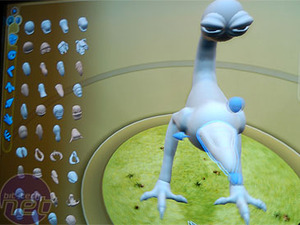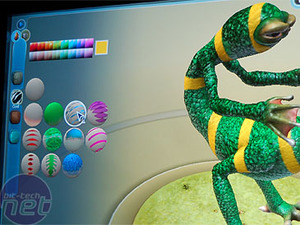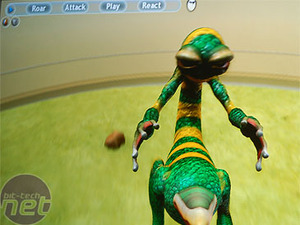"If this doesn't work, I'll just do Spore as an interpretive dance play..."
Will Wright is sitting in a darkened room with us, apologetic for the fact that the projector EA has brought to E3 isn't working. Sitting in the dark, around twenty attendees are sat patiently, eagerly awaiting our demo of Will's next game - Spore.
Wright is something of a gaming legend, being the man responsible for Sim City and The Sims. Spore is his latest, and most ambitious work. The premise is simple: take a single-cell organism, then evolve it and modify it all the way up the point where its resultant civilisation takes it up into space. Then, colonise space, form alliances, terraform new planets, and enter a whole new game.
In the demo we saw, Will took us through the basics of designing a creature, showing us the basic creature-level gameplay, then skipping forward to show us the space-game towards the end of the title. What follows is Will's narration of the demo, next to our hastily-grabbed pics.

The things that you create are sent to a central server, and the process of playing the game is actually the process of building up content that permeates everyone elses game universe.
Each one of these levels has a tool and we've worked a lot on trying to make these tools easy to use, to make it really interesting."

 "This is the creature editor. You start with this little thing... I can pull out a spine and extend it, I can manipulate it. You've also got parts. These are limbs, and it's all pretty much drag and drop. The parts have different ratings and costs, and they actually change the little sliders over here on the side of the screen which represent speed, strength and the like. All the parts are scaleable, I can change the muscle size, whatever.
"This is the creature editor. You start with this little thing... I can pull out a spine and extend it, I can manipulate it. You've also got parts. These are limbs, and it's all pretty much drag and drop. The parts have different ratings and costs, and they actually change the little sliders over here on the side of the screen which represent speed, strength and the like. All the parts are scaleable, I can change the muscle size, whatever.
We want that, in just a few minutes, the average player can create a fully realised character."

 "Now, these are procedural textures, which means we've taught the computer to do normally what a texture artist would do. These textures have different scripts, and they understand where to put shadows, where to put hightlights etc, and normally a computer artist would spend a couple of days doing this. We do it here in just a few milliseconds. You can also overlay different layers - I can put stripes on top of scales here.
"Now, these are procedural textures, which means we've taught the computer to do normally what a texture artist would do. These textures have different scripts, and they understand where to put shadows, where to put hightlights etc, and normally a computer artist would spend a couple of days doing this. We do it here in just a few milliseconds. You can also overlay different layers - I can put stripes on top of scales here.
In test mode, it can show me how it might move around - no two creatures will move the same - and it will also show you how it might behave. How I might roar, or play, or be scared.
We want the players to be able to enjoy, in a few clicks, something that a Pixar artist might spend weeks on."
Will Wright is sitting in a darkened room with us, apologetic for the fact that the projector EA has brought to E3 isn't working. Sitting in the dark, around twenty attendees are sat patiently, eagerly awaiting our demo of Will's next game - Spore.
Wright is something of a gaming legend, being the man responsible for Sim City and The Sims. Spore is his latest, and most ambitious work. The premise is simple: take a single-cell organism, then evolve it and modify it all the way up the point where its resultant civilisation takes it up into space. Then, colonise space, form alliances, terraform new planets, and enter a whole new game.
In the demo we saw, Will took us through the basics of designing a creature, showing us the basic creature-level gameplay, then skipping forward to show us the space-game towards the end of the title. What follows is Will's narration of the demo, next to our hastily-grabbed pics.

Editing
"So Spore has got a couple of things that are unique to it. One is that it occurs across all these different scales. You have these different levels of the game - Cell, Creature, Tribe, City, Civilization, Space - and every level has an associated Editor. Everything you're going to see in this demo is editable by the player.The things that you create are sent to a central server, and the process of playing the game is actually the process of building up content that permeates everyone elses game universe.
Each one of these levels has a tool and we've worked a lot on trying to make these tools easy to use, to make it really interesting."


We want that, in just a few minutes, the average player can create a fully realised character."


In test mode, it can show me how it might move around - no two creatures will move the same - and it will also show you how it might behave. How I might roar, or play, or be scared.
We want the players to be able to enjoy, in a few clicks, something that a Pixar artist might spend weeks on."

MSI MPG Velox 100R Chassis Review
October 14 2021 | 15:04










Want to comment? Please log in.